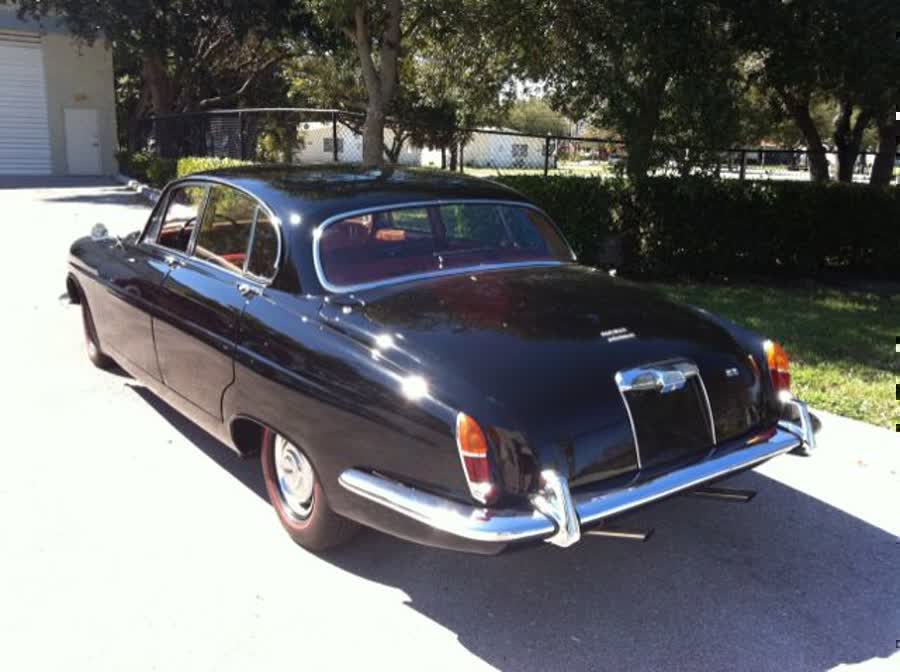

Transmission options were manual, manual with overdrive, or automatic. Triple SU carburettors were fitted, fed from an AC Delco air filter mounted ahead of the right hand front wheel. For the London Motor Show in October 1964 the enlarged 4,235 cc unit took over, although the 3.8-litre unit could still be specified until October 1965. A 9:1 compression ratio was standard, but an alternative 8:1 compression ratio was available as an option. Power initially came from the E-type's version of Jaguar's 3781 cc XK in-line six-cylinder engine designed by W Heynes, developing either 250 bhp (186 kW) or 265 bhp (198 kW), depending on compression ratio.

The front suspension used double wishbones with coil springs and telescopic dampers. It used a wider-track version of Jaguar's IRS unit first seen on the E Type, which was subsequently used on Jaguar vehicles until XJ-S production ended in 1996. It differed from earlier large Jaguar saloons in having 14" wheels instead of the more common 15". The Mark X was the first Jaguar saloon to feature independent rear suspension designed by William Heynes, who was Jaguar's Technical Director and Chief Engineer. Asked in 1972 if he thought the Mark X had grown rather too large, Jaguar chairman William Lyons, agreed that it "definitely" had: he opined that the then recently introduced and notably more compact Jaguar XJ6 was, by contrast an "ideal size". The substantial doors required helical torsion springs inside the door pillars to enable them to be opened from the inside with an acceptably low level of effort.įrom its introduction in mid-October 1961 until the arrival in 1992 of the low-slung XJ220, the Mark X stood as one of the widest production Jaguars ever built. Later, air conditioning and a sound-proof glass division between the front and rear seats were added as options. But at the same time, the interior was Jaguar's last to feature abundant standard woodwork, including the dashboard, escutcheons, window trim, a pair of large bookmatched fold out rear picnic tables, and a front seat pull-out picnic table stowed beneath the instrument cluster. Its floorpan remained in production in elongated form, long after Mark X production ended, forming the basis of the Daimler DS420 Limousine until 1992. Instead of relying on body-on-frame construction, like its predecessors and most of its competitors, the Mark X received a unitary body-shell, codenamed "Zenith" during its development. This front-end style reappeared on many of the manufacturer's successive saloons, up to and including the X-Type and third generation Jaguar XJ, both through 2009 - thereby forging Jaguar saloons' look for almost half a century. In 1961 the Mark X introduced a new upright, and slightly forward-leaning nose design for Jaguar saloons, with four headlamps set into rounded front fenders (derived from Daimler DK400), and a vaned grill. The rarest now is the Mark X with the 4.2 Ltr engine as only 5137 were built and few are known to survive. Jaguar didn't build another car as large as the Mark X / 420G for the rest of the century, until the LWB version of the 2003–2009 Jaguar XJ (X350). When Jaguar decided to replace its entire saloon range with a single new model, the resulting XJ6 of 1968 used the Mark X as a template – albeit with a reduced size.

ĭespite press acclaim from both sides of the Atlantic, the Mark X never achieved its sales targets.

Combined with the 3.8-litre, triple carburettor engine as fitted to the E-type, it gave Jaguar's flagship a top speed of 120 mph (193 km/h) and capable handling at less than half the price of the contemporary Rolls-Royce Silver Cloud. Contrary to its predecessors, the car featured integrated, unitary bodywork – the largest in the UK at the time, as well as independent rear suspension, unheard for early 1960s British luxury cars. Introduced in the same year as Jaguar's iconic E-Type, the Mark X impressed with its technical specification and innovations. The company hoped that the car would appeal to heads of state, diplomats and film stars. The large, luxurious Mark X succeeded the Mark IX as the company's top saloon model, and was primarily aimed at the United States market. The Jaguar Mark X (Mark ten), later renamed the Jaguar 420G, was British manufacturer Jaguar's top-of-the-range saloon car for a decade, from 1961 to 1970.


 0 kommentar(er)
0 kommentar(er)
